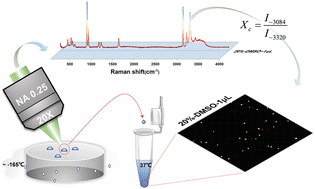A study on the relationship between the crystallization characteristics of quenched droplets and the effect of cell cryopreservation with Raman spectroscopy†
Abstract
The cryopreservation method of microdroplets has steadily become widely employed in the cryopreservation of microscale biological samples such as various types of cells due to its fast cooling rate, significant reduction of the concentration of cryoprotectants, and practical liquid handling method. However, it is still necessary to consider the corresponding relationship between droplet size and concentration and the impact of crystallization during the cooling process on cell viability. The key may be a misunderstanding of the influencing factors of crystallization and vitrification behavior with concentration during cooling on the ultimate cell viability, which may be attributable to the inability to analyze the freezing state inside the microdroplets. Therefore, in this work, an in situ Raman observation system for droplet quenching was assembled to obtain Raman spectra in the frozen state, and the spectral characteristics of the crystallization and vitrification processes of microdroplets with varied concentrations and volumes were investigated. Furthermore, the degree of crystallization inside the droplets was quantitatively analyzed, and it was found that the ratio of the crystalline peak to hydrogen bond shoulder could clearly distinguish the degree of crystallization and the vitrified state, and the Raman crystallization characteristic parameters gradually increased with the decrease of concentrations. By obtaining the cooling curve and the overall cooling rate of quenching droplets, the vitrification state of the microdroplets was confirmed by theoretical analysis of the cooling characteristics of a DMSO solution system. In addition, the effect of cell cryopreservation was investigated using the microdroplet quenching device, and it was found that the key to cell survival during the quenching process of low-concentration microdroplets was dominated by the cooling rate and the internal crystallization degree, while the main influencing factor on high concentration was the toxic effect of a protective agent. In general, this work introduces a new nondestructive evaluation and analysis method for the cryopreservation of quenching microdroplets.



 Please wait while we load your content...
Please wait while we load your content...